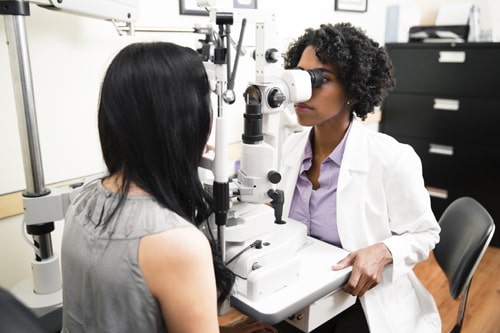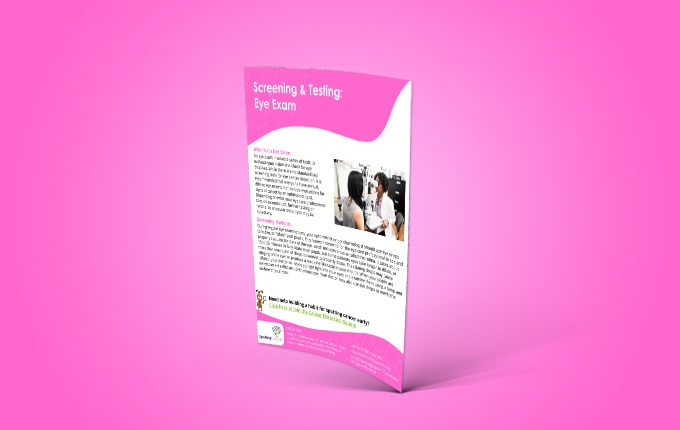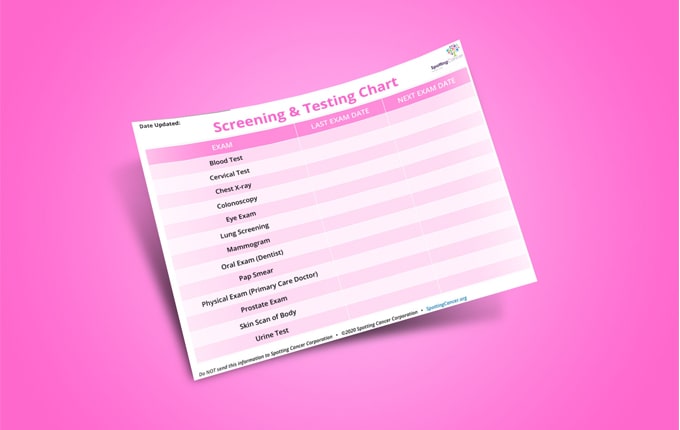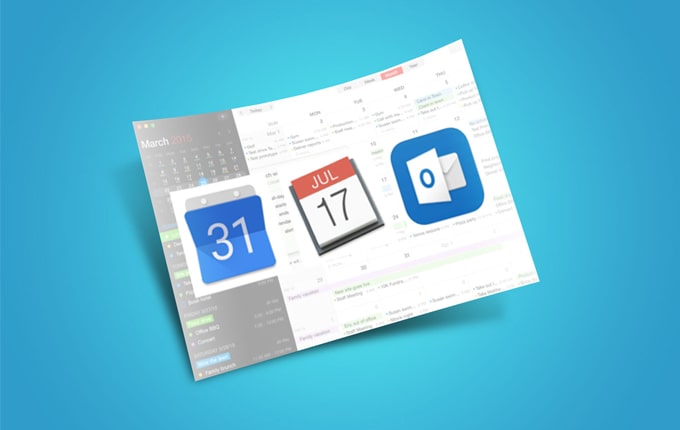Eye Exam (93, 94)
Cancer screening & testing helps you #SpotandSurvive

An eye exam involves a series of tests to evaluate your vision and check for eye diseases. While there are no standardized screening tests for eye cancer detection, it is recommended that everyone have annual, dilated eye exams that include evaluations for signs of cancer by an ophthalmologist. Depending on what your eye care professional sees on examination, further testing or referral to an ocular oncologist may be necessary.
Screening Methods:
During regular eye examinations, your optometrist or ophthalmologist should use eye drops to widen, or “dilate” your pupils. This makes it easier to for the eye care professional to see and properly evaluate the back of the eye, which includes a tissue called the retina. It takes about 15 to 20 minutes to fully dilate most pupils, but some patients’ eyes take longer to dilate, or more than one round of drops is needed to properly dilate. The dilating drops may cause stinging of the eyes or produce a medicine-like taste in your mouth. When your pupils are dilated, your doctor will shine a bright light into your eyes and examine them using a lamp and an instrument called an ophthalmoscope. Your doctor may also use eye drops to numb the surface of your eyes.
Some types of cancer of the eye can be more challenging to diagnose than others. Ocular lymphoma, for example, can appear as inflammation in the jelly-like substance inside the eye called the vitreous. Typically a biopsy is needed to confirm a suspected diagnosis of ocular lymphoma.
Your vision, especially up close, will be blurry for several hours after the examination (usually 4 – 6 hours). Reading and any other near tasks, including text messaging and use of a computer, will be challenging until the dilation effect has worn off. This is normal and expected. You will probably be able to go home or back to your usual activities right away, but be sure to protect your eyes from the sun by wearing sunglasses, as your eyes will be very light sensitive until the dilation wears off.
Additional testing may include:
Ultrasound. If anything suspicious is seen on initial exam at the microscope or with the ophthalmoscope, an ultrasound may be performed. A numbing drop will be placed in your eye. Then the doctor or ultrasonographer will move a small probe over the surface of your eye or eyelids to further evaluate the size, shape, and configuration of what was seen during the exam. This might be a little uncomfortable, but it should not be painful.
Biopsy. If indicated, and after discussion of the risks and benefits, your ophthalmologist (a medical doctor who has also undergone extensive training in evaluation and treatment of eye diseases including eye surgery) will use a small, hair-like needle to remove a sample of the fluid from inside your eye (vitreous). This sample will be sent to a lab, where a pathologist will examine it to see if there are any lymphoma cells. This procedure is done in an operating room while you are sedated with anesthesia. There is little to no recovery time in most circumstances. Biopsies are also used to evaluate for and diagnose other types of eye cancers on occasion. If you are diagnosed with any eye cancer, discuss with your ocular oncologist whether a biopsy is indicated and what information it could provide.
Preparation:
Due to the light sensitivity that occurs following dilation, you should arrange a ride to and from the appointment.
If you are having a general eye examination, it is recommended to remove your contact lenses prior to the evaluation.
If you are having a contact lens evaluation, you should wear your contact lenses so that the optometrist or ophthalmologist can check for proper fit and position.
Watch this video to see what happens during an eye exam.
Source: Brooklyn Independent Media
When:
Tests are normally done once a year.
Spot Cancer
Get reminder emails, tips, and resources to develop your spotting cancer habit when you join the Cancer Detection Squad

Take Action
Regular screening & testing is necessary to to spot cancer before it’s too late. Talk to your doctor or medical provider today to learn what cancer screening & testing is right for you.
you can
when you download and use our guides
Get the Screening & Testing Eye Exam
Download the guide to help you understand how an Eye Exam works and to learn the best time to schedule a screening. Share with your friends and family to help raise awareness on the importance of early cancer detection.
Get the Screening & Testing Scheduling chart
Download the interactive Screening & Testing Scheduling chart to help you keep track of important screening and testing schedules. Download today!
Save a Body Monitoring and Screening & Testing schedule
Regular monitoring and testing is a life-saving habit. Save a Body Monitoring and Screening & Testing schedule to your Google Calendar or iCalendar to stay on track!








